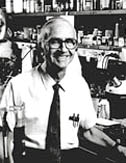| Home | |
| Faculty | |
| Graduate Program | |
| Events and Seminars | |
| Resources | |
| Contact Us | |
|
F A C U L T Y P R O F I L E
Current Research Studies in our laboratory demonstrate that the aorta of the rat is differentiated regionally for dynamic regulation of the properties of the vessel wall. The regulation occurs by cell signaling from the aortic endothelium, which is differentiated regionally, to the underlying smooth muscle cell layers. At least three signal pathways are involved, two of them well known. The formation of nitric oxide (NO) from L-arginine in aortic endothelium exhibits a characteristic activity pattern: greatest activity just distal to the aortic arch and progressively diminishing activity distally. The same regional pattern obtains for the formation and action of a product of the cyclooxygenase arm of the eicosanoid pathway, probably prostaglandin H2. The third signal pathway, a novel mechanism, exhibits the same regional pattern. Aortic endothelial cells convert the carbon atoms of L-leucine to L-glutamate. Nitric oxide and L-glutamate act on the underlying vascular smooth muscle to increase the level of cGMP (guanosine 3',5'-cyclic monophosphate), which results in smooth muscle relaxation. Prostaglandin H2 acts contrarily to decrease the level of cGMP. The aortic segment differentiated for these pathways corresponds to the "windkessel" region, the major elastic reservoir of the aorta. Dynamic regulation of the compliance and other viscoelastic properties of the aortic wall in this region can modulate important hemodynamic parameters including the arterial systolic and pulse pressures, the work of the left ventricle and the pulse-wave velocity.The new leucine-to-glutamate (leu-glu) pathway is of particular interest and under systematic study. The molecular and enzymatic mechanisms involved in the metabolic conversion, the transport steps and the physiological responses of vascular smooth muscle to glutamate are under investigation. We know that leucine derivatives and analogs can block the leu-glu conversion and markedly lower the cGMP levels of aortic smooth muscle. Drugs based on these leucine derivatives thus have the potential of affecting important vascular functions. The pancreas and the aorta exhibit the greatest leu-glu activity of rat tissues tested. To determine the functions of the pathway in pancreas, we have studied pancreatic segments incubated in vitro and characterized its biochemical properties. It is very similar to the aortic pathway and can be inhibited with leucine esters, L-valine and alpha-ketoisovalerate. We have shown that inhibition of the pathway impairs the stimulated exocrine secretion of the major pancreatic digestive enzymes, alpha-amylase, beta-lipase and tryptic enzymes. Further, inhibition of the pathway impairs glucose-stimulated insulin secretion. We now focus on the biochemical mechanisms by which the leu-glu pathway supports pancreatic stimulated exocrine and endocrine secretion. The approaches used in this laboratory encompass animal physiology, cellular biology, membrane biochemistry and molecular biology. The new leucine-to-glutamate (leu-glu) pathway is of particular interest and under systematic study. The molecular and enzymatic mechanisms involved in the metabolic conversion, the transport steps and the physiological responses of vascular smooth muscle to glutamate are under investigation. We know that leucine derivatives and analogs can block the leu-glu conversion and markedly lower the cGMP levels of aortic smooth muscle. Drugs based on these leucine derivatives thus have the potential of affecting important vascular functions. We have also demonstrated that the leu-glu pathway is prominent in certain other tissues: pancreas, lung, testes and ovaries. In the pancreas, for example, the islets of Langerhans carry out the conversion, and glutamate has been demonstrated to enhance insulin secretion. Possible regulation by glutamate of functions in these tissues will be explored. The approaches used in this laboratory encompass animal physiology, cellular biology, membrane biochemistry and molecular biology.
Selected Publications David Schachter and Jean Buteau. Glutamate formation via the leucine-to-glutamate pathway of rat pancreas. Am. J. Physiol. Gastrointestinal Liver Physiol. 306: G938-G946, 2014. Am. J. Physiol. Cell Physiol. 293: C142-C151. Schachter, D. 2007. L-Glutamine in vitro regulates rat aortic glutamate content and modulates nitric oxide formation and contractility responses. Am. J. Physiol. Cell Physiol. 293: C142-C151. Schachter, D., Sang, J.C. 2002. Aortic leucine-to-glutamate pathway: metabolic route and regulation of contractile responses. Am. J. Physiol. (Heart Circ. Physiol.) 282: H1135-H1148. Schachter, D., Sang, J.C. 1997. Regional differentiation in the rat aorta for a novel signaling pathway: leucine to glutamate. Am. J. Physiol. (Heart Circ. Physiol.) 273:H1484-H1492. Abbott, R.E, Schachter, D. 1994. Inheritance of salt-dependent hypertension in the inbred Dahl Rat. Hypertension 24:506-511. Abbott, R.E., Schachter, D. 1994. Regional differentiation in rat aorta: L-arginine metabolism and cGMP content in vitro. American Journal of Physiology 266:H2287-H22954.
|

